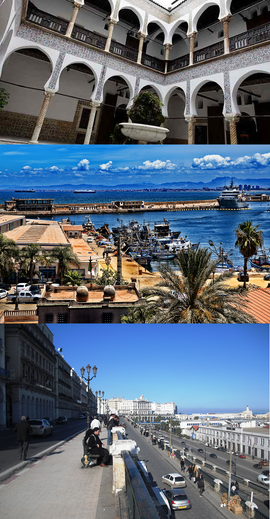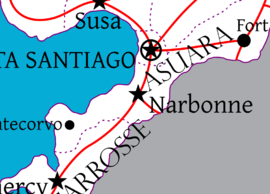Narbonne

|
This article or section is a work in progress. The information below may be incomplete, outdated, or subject to change. |
| City of Narbonne State Capital of Asuara | |||

| |||
| Top to bottom: the Arbābī Palace; the Bandar (old city port); the Terrasse Poitiers | |||
| |||
| Motto: "Je brille sur la mer comme le soleil" Alexandrian: "I shine upon the sea like the sun" | |||
| Anthem: | |||

| |||
| Map versions | 16.4.7-present | ||
| Official language(s) | |||
| Demonym | Narbonnaise | ||
| - Adjective | Narbonnaise | ||
| Government | |||
| Legislature | |||
| Establishment | 1668 AN | ||
| Area | |||
| Population | |||
| Currency | |||
| Abbreviation | |||
| Time zone(s) | |||
| Patron | |||
| Animal | |||
| Drink | |||
Narbonne is the capital city of the state of Asuara, within the Region of Alduria, Federation of Nouvelle Alexandrie. Though the city proper is not the most populous even within its own state - that being Fort Laons, followed in second place by Pontecorvo - it has an extensive metropolitan area that to some extent merges into that of Punta Santiago to the north. As a result, much of the state's population and industry can be found within and around Narbonne, and in some senses it is the gateway to the Southern Aldurian Riviera.
Name
- Alexandrian: Narbonne
- Martino: Narbona
- Wechua: Narpuna
- Babkhi: traditionally عسلويه / ‘Asalūyeh, sometimes also Narbūn
- Ladino: treditionally Saluya, but now more commonly Narbona
- Constancian: Ναρβο / Narvo
- Santanderian: Narbona
History
Although there had been people living in the region for eons, the settlement originally called ‘Asalūyeh dates from 1555 AN, when the declining Kingdom of Babkha ceded nearby lands to Ashkenatza as Mahoz HaSephardim, a homeland for the latter's Ladino-speaking Sephardic minority. Many Babkhans who were living in the Mahoz at the time of the cession departed in order to remain within the borders of their country, and ‘Asalūyeh was founded on the Gulf of Susa as a simple fishing village, in many ways a satellite of al-Santyaghu further north along the coast.
Though the village was not directly hit by nuclear devices or fallout during the nuclear holocaust that devastated Eura in 1598 AN, it suffered in the years afterward, being repeatedly sacked and raided, and changing hands numerous times between various petty warlords. The eventual construction of landward fortifications in 1612 AN aided the situation somewhat, and the village became a tiny hereditary despotate and a minor port for privateers operating along the northwestern coasts of Eura.
By the 1660s, northwestern Eura had become somewhat more stable, in the sense that the descendents of the Euran holocaust survivors had largely either settled down in prime locations, were relegated to a marginal existence elsewhere, or had died. The brief existence of Iteru marked a reappearance of state-level entities in the area, and although its own rule was cut short by the events of the Second Euran War, the Susan Gulf coast was relatively undisturbed. This made it a choice destination for refugees fleeing the crumbling military regime in Altus.
The Arbab (despot) of ‘Asalūyeh viewed the newcomers as an economic opportunity, and offered them a deal. The hills rising above the town were fit for habitation, but were sparsely populated; in exchange for settling there and providing taxes and allegiance to himself, he would offer them law and order, protecting them from the few remaining bandits operating there. They agreed, and through the late 1660s a string of settlements appeared.
This, however, triggered an even greater migration. The news of a region in a pleasant clime that welcomed Alexandrian settlers drew in members of the diaspora from New Alexandria in Natopia. Within the space of a few years, ‘Asalūyeh found itself surrounded by, and increasingly inhabited by, mainly Alexandrian-speaking people. The nearest, and largest, of the new settlements outside the walls was named Narbonne in 1668 AN.
The following year, the Republic of Alduria was proclaimed from nearby Punta Santiago. Many of the settlers, particularly those that had come later, were more inclined to give allegiance to the new republic than to a petty kinglet, and Babkhi merchants who were making good money off relations with the newcomers had no desire to antagonize their best customers. The Arbab of ‘Asalūyeh found himself increasingly sidelined, especially as the Altusian military was brought under Aldurian control.
Narbonne officially integrated into Alduria in 1671 AN, and became a local center of administration for the southern hinterlands of Alduria's mainland possessions. The despot, supported by certain segments of the Babkhi population, maintained a precarious autonomy for ‘Asalūyeh for several more years, but as it became clear that more and more of his subjects were finding his rule less profitable that it would be under Aldurian administration, he made the decision to surrender his position before someone decided to take it from him. After negotiating a pension for himself and his heirs, ‘Asalūyeh was incorporated into Alduria in 1674 AN.
The expansion of Aldurian territory south along the coast in the following years - into what would become the bulk of the Southern Aldurian Riviera - fueled a boom in local development. Both geographically and politically, Narbonne was well placed as a jumping-off point for settlers and construction crews heading south, standing between the cities of the north and the new territories.
‘Asalūyeh's importance as a port, already overshadowed by Punta Santiago, was further reduced after the founding of the more modern port of Pontecorvo in 1680 AN. Partly as a result of this, but also due to the increasing integration of the settlements, 1683 AN saw the incorporation of ‘Asalūyeh into the city limits of Narbonne. This unintentionally reflected the Babkhi usage, which had referred to both settlements as ‘Asalūyeh (with the portion outside the walls being simply Outer ‘Asalūyeh).
Coat of arms and flag
Geography
Climate
Cityscape
Architecture
Subdivisions
‘Asalūyeh
The original settlement from which Narbonne grew, effectively Narbonne's old city. The area still has a very Babkhi flavor in both architectural style and local culture. It is home to the Arbābī Palace and the Bandar, the city's port.

